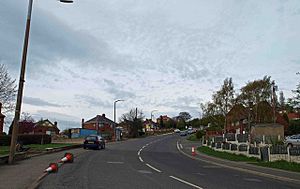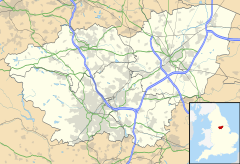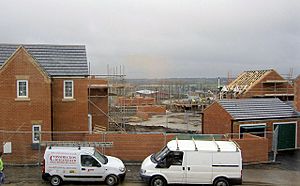Grimethorpe facts for kids
Quick facts for kids Grimethorpe |
|
|---|---|
 Brierley Road |
|
| Population | 4,672 (2011 census) |
| Metropolitan borough |
|
| Metropolitan county | |
| Region | |
| Country | England |
| Sovereign state | United Kingdom |
| Post town | Barnsley |
| Postcode district | S72 |
| Dialling code | 01226 |
| Police | South Yorkshire |
| Fire | South Yorkshire |
| Ambulance | Yorkshire |
| EU Parliament | Yorkshire and the Humber |
| UK Parliament |
|
Grimethorpe is a village in South Yorkshire, England. It is part of the Barnsley area. In 2011, about 4,672 people lived there.
Grimethorpe is in eastern Barnsley. Before 1974, it was part of the Hemsworth area. For many years, Grimethorpe was known for its coal mining. After the big miners' strike in 1984–85, the coal mines started closing. Grimethorpe's mine closed in 1993. In 1994, it was thought to be one of the poorest villages in Britain.
Today, Grimethorpe has good road links. It is home to around 50 businesses. This includes a large online fashion company called ASOS.
Contents
Village History
The name Grimethorpe comes from "Grim's Torp." This mixes old Anglo-Saxon and Viking words. It means a small village or farm owned by a Viking named Grimey. Grimethorpe is at the bottom of a hill. The village of Brierley is on top of this hill.
After the Norman Conquest in 1066, the area was ruled by the De Laceys. They were from Pontefract. The land was given to a Norman named Airic. He received a large area called Staincross wapentake. A "wapentake" was like a district in Yorkshire.
Ladycross and Hall Steads
Monks from Monk Bretton Priory built a stone cross near Grimethorpe. It was called Ladycross. This cross was a place of safety. People could find protection on Church lands. The "Lady" in the name likely refers to Mary Magdalene.
There was also a fortified manor house called Hall Steads. It was hidden between Brierley and Grimethorpe. This manor was surrounded by a high stone wall and a moat. It covered about five acres of land. Old pottery pieces from the 1300s and 1400s have been found there.
Mining in Grimethorpe
In 1981, almost half of all workers in Grimethorpe were miners. The village had two main coal mines. They were called 'Grimethorpe' and 'Ferrymoor'. Over time, these mines joined with others nearby.
Grimethorpe colliery was one of the deepest mines in Britain. When it closed in May 1993, it employed 6,000 men. During the 1984–85 miners' strike, there were strong disagreements in Grimethorpe. Local people felt that the police actions were too strict.
St Luke's Church was built in 1904. The older church in Brierley was not big enough for the growing village.
Village Challenges
After the mines closed, Grimethorpe faced tough times. More than half the people were out of work in the 1990s. This led to a long period of hardship. Local groups and charities worked to help the village.
Many old, basic houses were pulled down. New homes were built in their place. Grimethorpe had roads connecting it to other areas. However, it was far from big cities. Public transport mainly relied on long bus routes. Other former mining villages had train links to bigger cities like Leeds.
New Projects and Growth
Many projects have helped Grimethorpe grow again. New roads were built, like the Dearne Valley link roads. The Park Springs Industrial Estate was also developed. This brought many new jobs to the area. For example, a large furniture company called Symphony built a huge factory there.
Old mining offices were turned into 'The Acorn Centre'. This centre offers workshops and offices for small businesses. Honest Home Care Ltd, which employs over 40 people, is one of the biggest businesses there. The village also gained four new housing areas, a medical center, a dentist, and a village hall. Former Deputy Prime Minister John Prescott praised these changes in 2010.
Since then, more growth has happened. The large ASOS distribution center opened. Many other businesses have also moved into the Park Springs Industrial Estate.
Education in Grimethorpe
The village has two primary schools: Milefield and Ladywood. Grimethorpe used to have a secondary school called Willowgarth High School. It was replaced by a bigger school, Outwood Academy Shafton. This school serves students from Grimethorpe and nearby villages.
Another old school, Springvale Primary School, burned down in the 1980s. Milefield Primary School was built to replace it.
Grimethorpe Colliery Band
Grimethorpe is famous for its brass band, the Grimethorpe Colliery Band. The village and its band were featured in the film Brassed Off. This film is a comedy about the struggles of the village and how the band helps. In 2010, the band recorded "Jerusalem." This song was played when the English team won a gold medal at the Commonwealth Games.
Sports in the Village
Grimethorpe used to have two senior football clubs. They were called Grimethorpe Athletic and Grimethorpe Miners' Welfare. In 2018, former Barnsley FC player Bruce Dyer opened a football academy branch in the village.
In the comic strip Billy the Fish from Viz, a fictional team called Grimethorpe City is a big rival. They play against Fish's team, Fulchester United.
Images for kids
See also
 In Spanish: Grimethorpe para niños
In Spanish: Grimethorpe para niños






